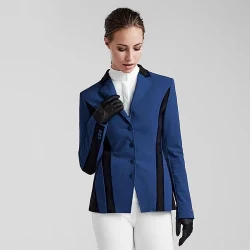Breakdown of show jackets and shirts
2023-12-04
Show jackets and shirts are essential components of formal equestrian attire, particularly in competitive riding disciplines. Riders wear these garments during horse shows and competitions, where a polished and professional appearance is expected. Here's a breakdown of show jackets and shirts:
Show Jackets:
1. Style:
- Show jackets, also known as riding jackets or show coats, are tailored, formal jackets worn by riders during competitions.
2. Material:
- They are typically made of high-quality materials such as wool or technical fabrics, providing a clean and polished appearance.
3. Color:
- Traditional show jackets are often dark in color, such as navy blue or black. However, some disciplines and competitions may have specific rules regarding acceptable colors.
4. Design:
- Show jackets are designed with a close fit to create a tailored silhouette. They often feature subtle details such as a velvet collar, three buttons, and a double vent at the back for ease of movement.
5. Discipline-Specific Features:
- Different riding disciplines may have specific requirements for show jackets. For example, dressage riders may wear shadbelly coats, which have a longer, tapered back, while hunter riders often wear more traditional hunt coats.
6. Accessories:
- Riders often pair show jackets with stock ties or chokers for a finished look. The choice of accessories may vary based on the discipline.
Show Shirts:
1. Style:
- Show shirts are formal, long-sleeved shirts worn under the show jacket. They are designed to provide a neat and professional appearance.
2. Material:
- Show shirts are typically made of lightweight, breathable materials such as cotton or technical fabrics. Some may have added stretch for comfort.
3. Color:
- While white is a traditional and widely accepted color for show shirts, certain disciplines may allow other light colors, such as pale blue or cream. Always check the specific rules of the competition or discipline.
4. Collar and Cuffs:
- Show shirts have a classic button-up style with a collar and cuffs. Some may have subtle design details like a textured fabric, a bib front, or a concealed button placket for a polished look.
5. Fit:
- The fit of a show shirt should be tailored but allow for freedom of movement. Riders often tuck the shirt into their breeches or jodhpurs for a neat appearance.
6. Accessories:
- Show shirts are often worn with a stock tie or a choker, which adds a touch of elegance and tradition to the overall ensemble.
Considerations:
- Discipline Rules:
- Different riding disciplines may have specific rules regarding the color, style, and accessories allowed for show jackets and shirts. Always check the rules of the specific competition or organization.
- Comfort:
- Choose materials that are comfortable and breathable, especially if you'll be riding in warmer weather.
- Fit:
- Ensure that both the show jacket and shirt have a proper fit. Tailored and well-fitted attire contributes to a polished and professional appearance.
- Accessorizing:
- Pay attention to the accessories, such as stock ties or chokers, as they can add a finishing touch to the overall look.
Show jackets and shirts contribute to the overall impression and presentation of a rider during competitions. While they adhere to tradition and formality, there's often room for subtle personal style within the guidelines of the specific discipline or competition.



